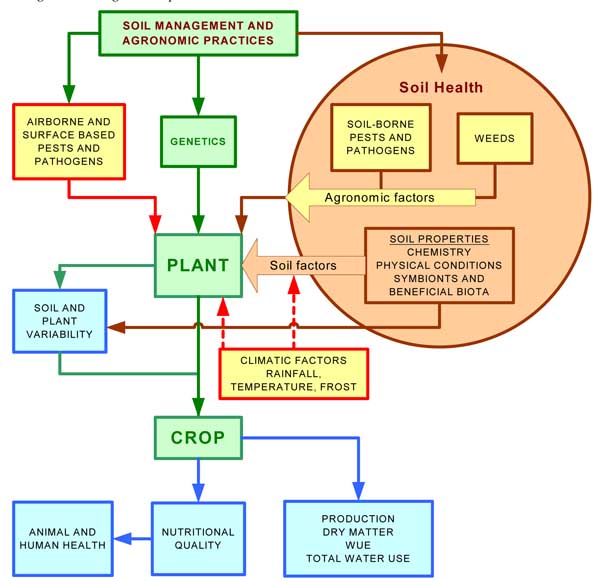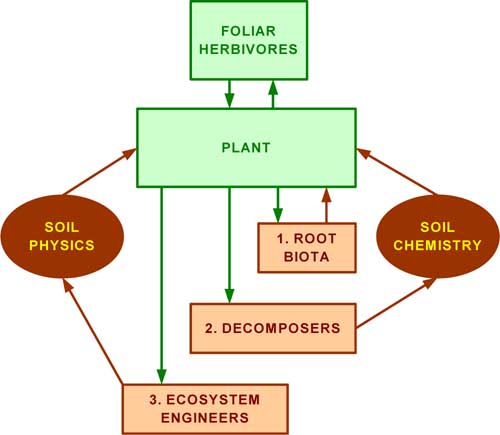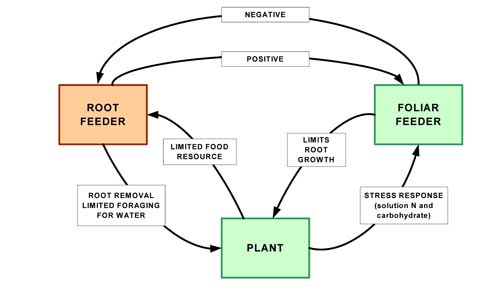3. Soil health in agro-ecosystems
Back to: Soil health for Victoria's agriculture - context, terminology and concepts
3.1 Production | 3.2 Variability | 3.3 Food quality | 3.4 Soil bioligy and soil health | 3.5 Soil health and plant health - resistance to pests and disease | 3.6 Soil health, nutrient cycling, crop residues and organic matter
The primary function of soil in agro–ecosystems is to support plant growth. This is a complex function that depends on many soil processes and properties. Plants integrate all of these as well as many other factors that are not directly related to soil. The plant can be used as the indicator of successful soil management or healthy soil provided the agro–ecosystem is appraised in order to identify all of the influences (edaphic and other environmental aspects) that affect plant performance. Agronomic choices determine; species and variety selection, rotations, fertiliser regime, pest and disease management, weed control, timing of operations, machinery and tillage, and the role of animals in the system. In animal production systems, plant production (quantity and quality) still serves as a suitable integrator of the system’s components.
Figure 2 illustrates the major components of the soil–plant system in an agricultural context with a focus on food products (rather than fibres or timber). Soil health, as the condition of the soil with respect to its capacity to support healthy plant growth, encompasses agronomic as well as soil quality factors. Soil–borne pests and pathogens, weeds, soil structure and fertility are all factors that can be managed directly by soil management and agronomic practices.

Figure 2 Diagram illustrating the relationships between agronomic and environmental factors affecting soil, plant, crop and animal health. (WUE = water use efficiency)
The aim of management is to create optimal soil conditions for plant growth but there are many examples of practices that have beneficial as well as negative effects. Balancing these effects to achieve optimal soil health is a major challenge and selection of appropriate indicators for soil health is confounded by this complexity. What can or should we monitor in order to indicate soil health through plant performance?
3.1 Production
Total dry matter production per unit input or economic yield for a particular plant species does not depend on soil condition alone but also depends on genetics (vigour, susceptibility or resistance to disease, environmental suitability), seasonal characteristics (rainfall amount and timing, frost incidence, growing season temperatures) and other external factors such as airborne diseases and pests. Plant performance may be measured for individuals in a stand but is more commonly assessed at a plot, paddock, or even regional level. Airborne or satellite remotely sensed imagery can be analysed for spectral signatures that indicate plant performance at regional, paddock and sub–paddock scales. These approaches and the application of Normalised Difference Vegetation Index (NDVI) in particular are described in Appendix A.
3.2 Variability
At the stand level, crop variability may be due to abiotic soil factors (soil variability, depth, texture, water availability), as well as soil borne pathogens, airborne pathogens, insect attack, grazing, rabbits, frost prone areas, weed competition, spray misses or other management variations. Consistent patterns of crop variability in different seasons are more likely to be a reflection of differences in soil type and quality rather than in soil health, so comparison of high and low yielding areas need to be interpreted carefully. In such cases, paddock zoning to vary inputs is an important aspect of management for soil health as well as economic farm management.
3.3 Food quality
Nutritional quality (protein and digestibility) is positively related to soil quality and soil health. Differences in nutritional quality within a stand may be the result of soil type (and therefore quality) differences but could also be a reflection of differences in soil condition (and therefore soil health). An aspect of healthy soil is its capacity to produce high quality feed (for stock animals or for human consumption), having the optimal combinations of digestible carbohydrate, protein and fats, balanced mineral composition, appropriate fibre, and lack of toxins or contaminants.
3.4 Soil biology and soil health
Soil biology is extremely complex. In many respects soil biology is regarded as the key to soil health – it is the life in the soil and a regulator of many processes that affect soil chemistry and soil physics. However, because of its complexity, there are few certainties that can be derived from our knowledge of soil biology to provide quantitative indicators of soil health. Most of the claims regarding optimal soil biological constitution and the interactions between agricultural management, soil biology and soil health are found at or beyond the fringes of agricultural research. New methods in biological research, particularly molecular techniques (Johnson, Lee and Scow 2003) offer some promise of precision in the identification of microbial communities. The Soil Biology subplatform of PIRVic, DPI is currently pursuing this line of research.
Soil organic matter is universally accepted as the major indicator of soil biological health. The function that soil organic matter performs for soil structure has been extensively reviewed by Carter and Stewart (1996). Magdoff and Weil (2004) provide a more recent review of the management of soil organic matter. A perspective on the state of knowledge regarding indicators appropriate for soil biological health is included as Appendix C to this report.
Summaries of the functions of soil organisms can be found in standard texts. A useful review is provided by Brussard (1998) who has reviewed some of these functions and explained how the plant plays a central role in governing, and providing a biological assessment of, the roles soil fauna play in ecosystem processes. In his review Brussard (1998) describes these roles and proposes a framework for understanding the ecological interactions between food webs, the plant, soil organic matter and the soil ecosystem. Simple frameworks that illustrate the principal interactions are shown in Figure 3 and Figure 4.
There are five main criteria that have been used to group assemblages of soil organisms: life–history tactics, microhabitat, principal food, feeding mode and ecophysiology. Brussaard (1998) presented an evaluation of the functional classification of soil organisms and described three ‘guilds’ of soil organisms: root biota, decomposers and ecosystem engineers. Figure 3 illustrates the central place of the plant in soil ecosystem functioning. The micro–predators comprise a fourth group (not described by Brussaard). These have an indirect impact on the plant through regulation of populations of other soil micro–biota.

Figure 3 Conceptual diagram of an interactive web, showing main interactions between plants and biotic and abiotic constituents (from Brussaard 1998).
The interactions between plant and root biota (1) are instantaneous and may be positive symbioses such as occur between the plant and mycorrizhae, or they may be deleterious to the plant due to root diseases or pests. The plant affects decomposers (2) by supplying organic matter as a substrate that is subsequently recycled as nutrients via the soil solution to be taken up by the plant. Earthworms, ants and termites are examples of ‘ecosystem engineers’ (3) that also receive their substrate from the plant but affect the plant largely through the modified physical environment, in particular by changes to macro–porosity and aggregation of soil components. The foliar herbivores feeding on aerial portions of the plant interact directly with the plant but also interact indirectly, through the plant’s response to soil conditions (see, for example, Altieri and Nicholls 2003). Feedback mechanisms between root and foliage with respect to herbivory are illustrated simply in Figure 4.

Figure 4 Conceptual model of interactions between above– and below–ground herbivores (after Masters et al. 1993, reproduced in Brussaard 1998).
3.5 Soil health and plant health – resistance to pests and diseases
Insect pests and soil health
Plant nutrition can affect plant pest problems (Altieri and Nicholls 2003) by altering plant tissue nutrient levels. There is evidence that lesser incidence of disease and attack by insect pests is associated with soil quality or optimal physical, chemical and biological conditions. There are strong proponents of alternative farming methods who emphasise the importance of organic matter and the need to reduce or eliminate the use of inorganic fertilizers. In particular, high N rates have been shown to increase aphid and mite numbers in most studies. However, as a minority of these studies were field–based, the results may not be indicative of field crop performance. More research is needed to confirm causal relationships and to identify critical values or ranges for key properties, should they exist. Altieri and Nicholls (2003) observe that despite the potential relationships between crop protection and soil management, there has been no combined development to link integrated pest management with management of soil fertility.
Nematodes and soil health
Nematodes in soil belong to several different groups: plant–parasitic and plant–pathogenic nematodes, fungi and bacteria–feeding nematodes, and predatory nematodes. The latter two groups are considered to be beneficial or harmless to plants. Functionally, the nematodes have direct and indirect impacts on organic matter decomposition, nitrogen mineralisation and dispersal of both beneficial and harmful bacteria. Kimpinski and Sturz (2003) have reviewed what is known of the dynamics of nematode populations and conclude that system complexity and population fluctuations confound the use of nematodes as indicators, except for extreme situations. Understanding of these dynamics and the environmental factors controlling them is a critical area for future research. Recent work by the DPI in Queensland has compared nematode populations in bananas treated with different mulch materials (Cobon and Pattison 2006). This work has shown promise in modifying the proportions of the major nematode groups and reducing the populations of harmful nematodes. They also suggest that nematodes are excellent bio–indicators because of their position in the food web and their relatively stable numbers over time compared to microbial dynamics.
Weed– and disease–suppressive soils
Kremer and Li (2003) investigated soil microbial activity in seven cropping systems and compared weedsuppressive bacteria and soil enzyme activity in these systems. They found general associations between weed–suppressive activity and disease–suppressive soils (associated with high soil enzyme activity), high organic matter content and increased water–stable aggregation.
3.6 Soil health, nutrient cycling, crop residue and organic matter
Cycling of nutrients is a primary function of soil necessary to sustain plant growth. The cycling that takes place through the breakdown and incorporation of plant and animal residues also has important impacts on soil structure at macro and micro–scales. The roles of soil biota across all scales of the food web (Appendix C) are critical to these processes. In dryland cropping systems (grains) there are widely different management practices dealing with plant residues between harvest and sowing. Crop residue (stubble) is a valuable source of nutrients, a potential protection for the soil surface, habitat and food supply for a range of animals and an important soil conditioner. Retention of residue is not simple and can cause problems. Build up of slugs and pests, interference with sowing and depth control, uneven germination, and lock up of nitrogen are some examples of issues that can arise. Incorporation of crop residues, through tillage, exposes the soil to the elements, can lead to net loss of soil carbon and may damage soil structure. Burning of residues releases nutrients but deprives the soil of bulky organic matter, exposes the soil and contributes to atmospheric pollution. Consistently reliable systems for managing crop residues to maximise their benefits to soil are needed. While design of farm machinery is a major factor that can assist with this, there is also a role for biological improvements. Spraying of stubble with cellulose–digesting fungi is an option, but natural populations of arthropods, in particular, depend on the presence of organic material (Blumberg and Crossley 1983) and can serve as useful indicators of soil health (Olfert et al. 2002).


